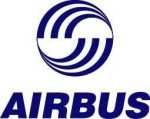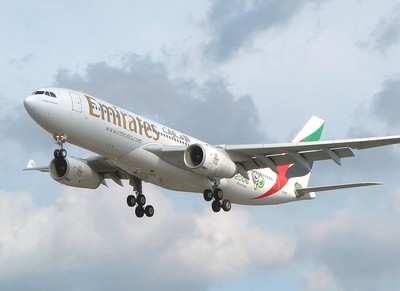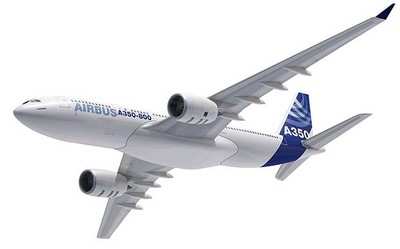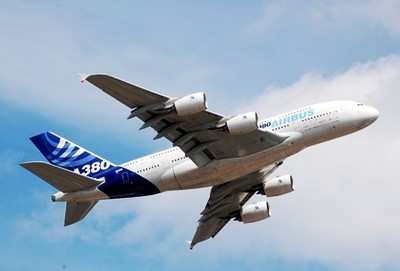Total Spending Worldwide On Airliners Could Climb To $3.2
Trillion, Airbus Says
 Almost 26,000 new passenger and freighter aircraft valued at
$3.2 trillion will be needed between 2010 and 2029 to satisfy
demand. At least, that is the view of Airbus according to its
Global Market Forecast (GMF). This demand is primarily driven by
replacement of aircraft for newer more eco-efficient models in
mature markets, dynamic growth in new emerging markets, low-cost
carriers particularly in Asia, further market liberalisation and
capacity growth on existing routes.
Almost 26,000 new passenger and freighter aircraft valued at
$3.2 trillion will be needed between 2010 and 2029 to satisfy
demand. At least, that is the view of Airbus according to its
Global Market Forecast (GMF). This demand is primarily driven by
replacement of aircraft for newer more eco-efficient models in
mature markets, dynamic growth in new emerging markets, low-cost
carriers particularly in Asia, further market liberalisation and
capacity growth on existing routes.
The 2010 GMF forecasts 900 additional new passenger aircraft
deliveries over the 2009 GMF reflecting a slightly higher growth
rate of 4.8% compared to 4.7% in 2009. These aircraft will mainly
be in the single aisle sector in which the A320 Family
competes.
Out of the almost 26,000 additional passenger and freighter
aircraft needed, around 25,000 will be passenger aircraft valued at
over US$2.9 trillion. Of these additional passenger aircraft,
10,000 will replace older less eco-efficient aircraft and some
15,000 will be for growth. Taking into account today's passenger
fleet of over 14,000 aircraft, the world passenger fleet will rise
to some 29,000 aircraft by 2029.
"The recovery is stronger than predicted and reinforces both the
resilience of the sector to downturns and that people want and need
to fly," says John Leahy, Chief Operating Officer Customers. "The
single aisle sector is particularly strong, and our A320neo meets
this future demand by providing our customers with the latest
innovations and technologies whilst maintaining maximum
commonality. Our entire product range is very well positioned to
meet the economic and environmental needs for sustainable growth
for the decades ahead."

In passenger traffic volume, domestic US leads the world in
total RPK's (11.3%) followed by domestic China (8.4%), Intra
European (7.2%), then US to Western European routes (5.9%). In
passenger traffic growth terms, emerging economies are leading the
recovery. Domestic Indian traffic growth (9.2%) is the fastest of
any major market and the third fastest growth overall, after
traffic between the Middle East and South America, and between
North Africa and the People's Republic of China (PRC). Seven out of
the top 20 fastest growth flows connect China (PRC) to the rest of
the world.
"Airlines in Asia Pacific including China and India will carry
one third (33%) of the passenger traffic by 2029, making it the
largest region, overtaking the US (23%) and Europe (23%)," said
Chris Emerson, Head of Product Strategy and Market Forecast.

Aircraft are getting bigger as airlines capitalize on the
benefits of larger aircraft to absorb traffic growth, minimize
airport congestion, reduce costs and to increase
eco-efficiency.
Freight traffic is recovering at an even faster rate (5.9%) than
passenger traffic growth. In 2010, freight traffic is expected to
rebound closer to 18% before leveling off at more typical growth
levels by the end of 2011. Combined with fleet renewal, this
translates to a demand for around 2,980 freighters. While some 870
will be new aircraft valued at US$211 billion, 2,110 will be
converted from passenger aircraft.
The Airbus report sees demand for Very Large Aircraft (VLA)
passenger and freighter aircraft to be more than 1,700 valued at
over $570 billion. Of these, some 1,320 will connect the world's
increasing number of 'mega' cities.

In the twin-aisle aircraft segment (seating from 250 to 400
passengers), some 6,240 new passenger and freighter aircraft will
be delivered in the next 20 years, valued at some $1,340 billion.
Of these, 4,330 aircraft will be small twin-aisle (250 to 300
seater) and about 1,910 intermediate twin aisles (350 to 400
seats).
In the single-aisle segment, almost 17,900 aircraft worth some
$1,274 billion, will be delivered in the next 20 years. This is an
increase over previous forecasts due to the accelerating demand for
single aisle aircraft particularly in Asia Pacific, the emergence
of low-cost carriers and increased route liberalization.
 ANN's Daily Aero-Term (12.14.25): Local Airport Advisory (LAA)
ANN's Daily Aero-Term (12.14.25): Local Airport Advisory (LAA) Airborne 12.08.25: Samaritans Purse Hijack, FAA Med Relief, China Rocket Fail
Airborne 12.08.25: Samaritans Purse Hijack, FAA Med Relief, China Rocket Fail ANN's Daily Aero-Linx (12.15.25)
ANN's Daily Aero-Linx (12.15.25) Airborne 12.10.25: New Gulfstream, ATC Integrator, Outrageous FFZ User Fees
Airborne 12.10.25: New Gulfstream, ATC Integrator, Outrageous FFZ User Fees Airborne-NextGen 12.09.25: Amazon Crash, China Rocket Accident, UAV Black Hawk
Airborne-NextGen 12.09.25: Amazon Crash, China Rocket Accident, UAV Black Hawk






